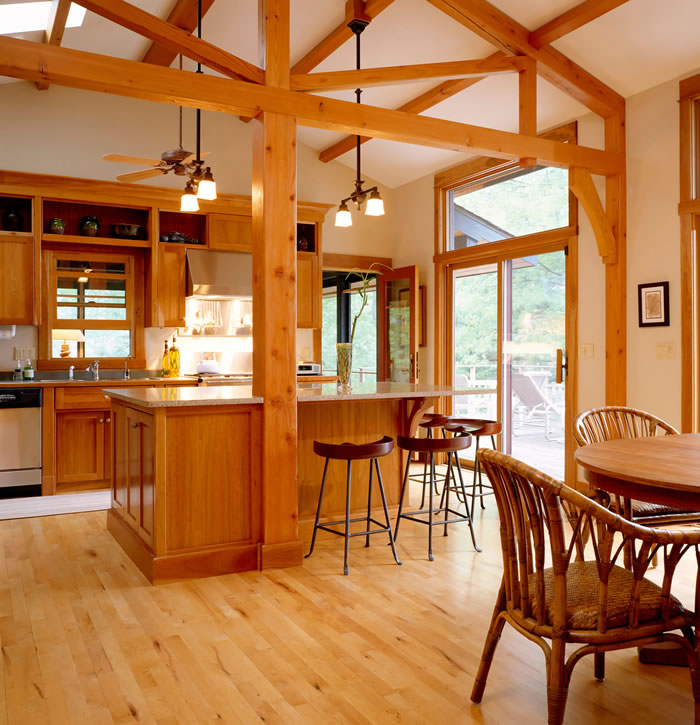An Expert’s Guide to Hardwood Flooring
As you plan your home and office improvements, think long-term by making choices that are informed, responsible and financially sound. The American Hardwood Information Center suggests hardwood flooring – one of the best long-term investments to be made. It is environmentally friendly, forever fashionable, and will last for generations. And industry experts concur.
Bob Sabistina, executive director of the American Walnut Manufacturers Association, and international lumber grading consultant to the American Hardwood Export Council (AHEC), www.ahec.org, recently shared the following information about hardwood flooring options, installation, care and maintenance.
Solid Hardwood Flooring
Solid hardwood flooring is just that; a solid plank of hardwood milled into a piece of flooring, usually with a tongue and groove on the edges and ends, so that the pieces fit together on all sides. While it comes in a variety of thicknesses, ¾ inch is the most common produced in the U.S. and is usually nailed to a wooden subfloor. Thinner profiles, such as 5/16 inch, can be glued directly on to a surface such as concrete. Widths typically range from 2 ¼ inch strip to 8 inch and wider plank. Favorite U.S. species are red and white oak, hard maple, ash, hickory and pecan, walnut and cherry. All solid hardwood flooring can be sanded and refinished, however special care must be taken with the thinner profiles. And in all cases of hardwood flooring installation, a clean, moisture-free surface is essential to eliminate future problems with movement or moisture.
Two Types of Solid Hardwood Flooring
Unfinished solid hardwood flooring comes directly from the mill and is sanded and finished onsite. Most often used in new home construction, the rough sanding occurs during the early stages of the building process with the final coating being done just prior to move-in. Today’s numerous dust containment sanding systems however, allow homeowners to enjoy the beauty of site finished, custom hardwood flooring practically anytime.
Prefinished solid hardwood floors have already gone through a multiple stage finishing process before leaving the factory. They are ready to be enjoyed. This type of flooring usually comes with a substantial factory warranty, and species choices and color ranges are virtually endless.
Engineered or Multi-layer Hardwood Flooring
Engineered hardwood flooring is typically made from seven to ten layers of thin veneers or sheets, glued together to form a type of plywood, then finished with a solid hardwood wear layer. It can be installed directly over concrete and most other types of subfloors. The advantage of engineered hardwood flooring is that it will not react to moisture changes and is more stable than solid hardwood flooring. Because of this stability, engineered is recommended over solid in wide plank applications. Depending on the thickness of the wear layer, an engineered floor will perform in much the same way same as a solid floor.

Hand Scraped Hardwood Flooring
With this type of flooring – available in solid or engineered, unfinished or prefinished – the manufacturer hand scrapes each piece of flooring to mimic the look of an old, worn floor. This look is most popular in wide planks for that “old world” charm. But a word of caution – to refinish these floors, all the detail will be removed in sanding.
Care and Maintenance
Care and maintenance of hardwood flooring is easy; often just a matter of common sense. Follow these simple guidelines and your floors will last a lifetime, providing the warmth and feel only real hardwood can offer.
- Water is a hardwood floor’s worst enemy. Clean up spills immediately. Do not use a damp mop or oil-based soap. Always check with the flooring manufacturer for recommended cleaning products.
- Sweep hardwood floors regularly. Dirt and dust can grind into the finish. Consider doormats at every entrance – rugs in high traffic areas.
- Sunlight can be harmful and can drastically change the color of the wood. Consider sheer drapes, curtains or blinds to limit direct sunlight.
- Shoes can also cause damage. High heels can dent. Small stones can scratch. Consider leaving shoes and the grit of the outside world at the door.



